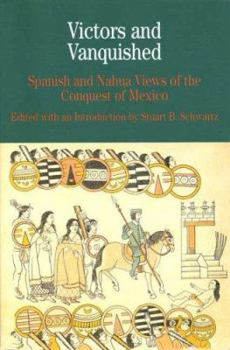Victors and Vanquished: Spanish and Nahua Views of the Conquest of Mexico
Select Format
Select Condition 
Book Overview
In 1519 Hern n Cort s and a small band of Spanish conquistadors overthrew the mighty Mexican empire of the Aztecs. Using excerpts primarily drawn from Bernal Diaz's 1632 account of the Spanish victory and testimonies -- many recently uncovered -- of indigenous Nahua survivors, Victors and Vanquished clearly demonstrates how personal interests, class and ethnic biases, and political considerations influenced the interpretation of momentous events. A substantial introduction is followed by 9 chronological sections that illuminate the major events and personalities in this powerful historical episode and reveal the changing attitudes toward European expansionism. The volume includes a broad array of visual images and maps, a glossary of Spanish and Nahua terms, biographical notes, a chronology, a selected bibliography, questions for consideration, and an index.
Format:Paperback
Language:English
ISBN:0312393555
ISBN13:9780312393557
Release Date:November 2000
Publisher:Bedford Books
Length:271 Pages
Weight:0.65 lbs.
Dimensions:0.5" x 5.4" x 8.1"
Customer Reviews
2 ratings
Excellent sourcebook for teaching college history
Published by Thriftbooks.com User , 19 years ago
This well edited text brings students the documents behind the stories they may have read in high school textbooks. How did the Spanish conquer the spectacular city of Tenochtitlan with so few soldiers and in alien territory? The documents tell how they exploited alliances that were already in place. With hundreds of Tlaxcalan warriors accompanying them, housing them, feeding men and horses alike, the group of Spaniards was able to approach Tenochtitlan, make themselves unwelcome, and barely escape from the city alive... A fascinating read.
My Review
Published by Thriftbooks.com User , 20 years ago
When the British Empire relinquished control to India, the jewel in the British crown, it became evident the age of Imperial European expansionism had come to an end. The period of global decolonization following World War II paved the way for a more critical approach to colonial history. The Euro-centric historical narratives of the colonial conquests were no longer acceptable within the academic community or for that matter entirely accurate. Stuart B. Schwartz a Professor of History at Yale University has set out to ensure the history of the conquest of Mexico is not written exclusively by the winners, but rather to present a fair and balanced compilation of European and Native American primary sources complemented by his own expert analysis. "Additional alternate texts paint a broader, richer canvas, fleshing out the narrative and conveying to the reader a sense that there was not simply a "Spanish" or an "Indian" view. Rather, there are a variety of visions and opinions, influenced and mediated by personal interests, class and ethnic biases, political considerations, and many other factors." The introduction provides the reader with a comprehensive description of Mesoamerican and Spanish societies on the eve of the conquest. Included is the rise to power of the Mexica Empire through conquest and expansion and the foundation of the empire's island capital at Tenochtitlan. The author describes the historical background of the primary sources which constitute the majority of the narrative. Nahua sources are drawn primarily from The Florentine Codex, a post-conquest study of indigenous history and culture conducted by literate natives under the auspices of a Spanish missionary named Fray Bernardino De Sahagun. Erudite natives rather quickly adopted the Roman alphabet, for the most part abandoning the use of Nahuatl hieroglyphics, and by the late 1500's were capable of writing both Spanish and Nahuatl. However, the reader is advised of the existence of tribal differences and patron appeasement reflected within the codex as historical partiality as the greater part of Sahagun's indigenous informants were from Tlatelolco, a city under Tenochtitlan political control, and highly critical of the Mexica Empire and Montezuma. The principal Spanish source is Bernal Diaz del Castillo's book The True History of the Conquest of New Spain which chronicles the conquest from a soldier's perspective. Despite the wandering and crude prose of Bernal Diaz, his account documents the typical conquistador's motivations and justifications for the conquest, reveals the true scope of the clash of cultures beginning with the first encounters up to the fall of Tenochtitlan, and provides indispensable anecdotes from a human voice and mind of reason which serve to bring the events and personalities of the conquest to life for the student of Mesoamerican history. The book is divided into eight chapters proceeding in chronological order from 1518-1521. Each sec






